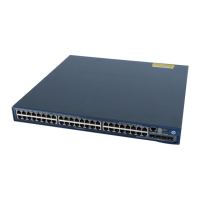71
In RSTP mode, all ports of the device send RSTP BPDUs. If the device detects that it is connected to a
legacy STP device, the port that connects to the legacy STP device will automatically migrate to STP-
compatible mode.
In MSTP mode, all ports of the device send MSTP BPDUs. If the device detects that it is connected to
a legacy STP device, the port that connects to the legacy STP device will automatically migrate to
STP-compatible mode.
Make this configuration on the root bridge and on the leaf nodes separately.
Follow these steps to configure the MSTP work mode:
Configure the work mode of
MSTP
stp mode { stp | rstp | mstp }
Required
MSTP mode by default.
Configuring the priority of a device
Priority is a factor in spanning tree calculation. The priority of a device determines whether it can be
elected as the root bridge of a spanning tree. A lower numeric value indicates a higher priority. You can
set the priority of a device to a low value to specify the device as the root bridge of the spanning tree. An
MSTP-enabled device can have different priorities in different MSTIs.
Make this configuration on the root bridge only.
Follow these steps to configure the priority of a device in a specified MSTI:
Configure the priority of the
current device in a specified MSTI
stp [ instance instance-id ] priority
priority
Required
32768 by default.
CAUTION:
You cannot change the priority of a device after it is configured as the root bridge or as a secondary root
bridge.
During root bridge selection, if all devices in a spanning tree have the same priority, the one with the lowest
MAC address will be selected as the root bridge of the spanning tree.
Configuring the maximum hops of an MST region
By setting the maximum hops of an MST region, you can restrict the region size. The maximum hops
configured on the regional root bridge will be used as the maximum hops of the MST region.
Configuration BPDUs sent by the regional root bridge always have a hop count set to the maximum value.
When a switch receives this configuration BPDU, it decrements the hop count by 1, and uses the new hop
count in the BPDUs that it propagates. When the hop count of a BPDU reaches 0, it is discarded by the
device that received it. Devices beyond the reach of the maximum hop can no longer participate in
spanning tree calculation, so the size of the MST region is limited.
Make this configuration on the root bridge only. All devices other than the root bridge in the MST region
use the maximum hop value set for the root bridge.

